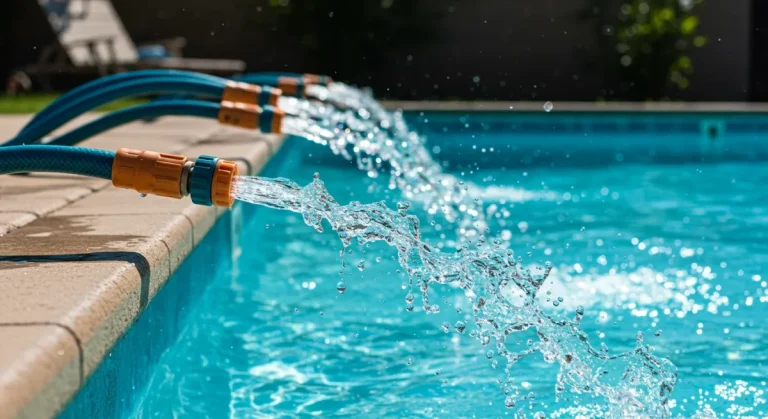How to Keep Deer Out of Your Garden with Fishing Line: The Complete DIY Guide
There are few things more soul-crushing for a gardener than waking up to see your hard work—your vibrant zinnias, your budding tomato plants—mowed down to sad little nubs. You pour your heart into your garden, only to have it become an all-you-can-eat buffet for the local deer population.æ
But what if I told you there’s a better way? A method that’s incredibly cheap, almost invisible, and plays on a deer’s own psychology to keep them out for good? Welcome to the world of the fishing line deer fence. Get ready to reclaim your garden.

Why Does a Fishing Line Fence Actually Work? Understanding Deer Psychology
I know what you’re thinking. “A piece of plastic string is going to stop a 150-pound animal?” It sounds crazy, but the secret isn’t in its strength; it’s in its mystery.
Deer, for all their grace, have surprisingly poor vertical depth perception. They are creatures of habit and caution. When a deer confidently approaches your garden and suddenly feels this strange, invisible thing touching its nose or neck, it triggers an immediate alarm. It can’t see it, it can’t identify it, and it can’t understand it. It’s not a branch, and it’s not a vine… It’s just a spooky, unseen barrier.
Think of it like you walking through a dark room and running face-first into a single, sticky strand of a spiderweb. You can easily break through it, but you don’t. You recoil, startled and confused. That’s exactly what a deer does. This deep-seated uncertainty is often more effective than a physical wall because it makes them too nervous to proceed.
The Simple Materials You’ll Need
Here’s the best part: the shopping list for this project is short, simple, and incredibly cheap. You likely have some of these materials already.
The Posts: Your Fence’s Backbone
You can use anything from metal T-posts (the most durable option), simple rebar stakes, or even sturdy wooden posts. The key is that they’re tall enough. Aim for posts that are at least 4-5 feet tall. If you need to cut wooden posts to size, a good hand saw for cutting trees will be helpful.
The Fishing Line: The Secret Weapon
Don’t overthink this, but don’t go too flimsy either. A 30-pound monofilament fishing line is the sweet spot. It’s strong enough not to snap in the wind but thin enough to be nearly invisible. You don’t need the expensive braided stuff; cheap and clear is perfect for this job.
Essential Tools
You’ll just need a small sledgehammer or mallet to drive your posts, a tape measure, and a good pair of work gloves to save your hands. It’s wise to keep everything together in a good tool bag for maintenance so you’re always ready for quick repairs or adjustments.
Step-by-Step Guide: Building Your Invisible Deer Fence in Under an Hour
This is a perfect weekend project that delivers immediate results. Just follow these simple steps.
Step 1: Plan Your Perimeter
Walk the perimeter of the garden you want to protect. Decide where your posts will go. You’ll want one at each corner and then spaced about 8-10 feet apart along the straightaways for good support.
Step 2: Drive Your Posts
Using your mallet, drive the posts about a foot into the ground so they are sturdy and don’t wobble. Consistency is more important than brute force. Make sure they are all roughly the same height.
Step 3: String the First Line
This is the most important line. Tie your 30 lb fishing line securely to your first corner post at about nose-height for a deer—roughly 2.5 to 3 feet off the ground. Walk the line to the next post, wrap it around once or twice, and pull it taut (but not banjo-string tight!). Continue this all the way around your perimeter until you get back to the start.
Step 4: Add a Second (and Maybe Third) Line
For best results, a single line isn’t enough. Add a second line about 18 inches off the ground to deter them from trying to go under. If you have high-jumping deer in your area, adding a third line near the top of your posts creates an even more confusing barrier for them to navigate.
Pro-Tips to Make Your Fence Even More Effective
Want to level up your spooky fence? Add a visual or auditory element to enhance the psychological effect.
- Fluttering Flags: Tie small, white strips of a plastic bag or brightly colored survey tape to the line every 10 feet or so. When the wind blows, they flutter, creating unexpected movement that makes deer even more nervous.
- The Sound-and-Light Show: For a multi-sensory attack, hang a few disposable aluminum pie tins from the line. They’ll flash in the sun and make a little clatter in the wind, adding to the deer’s confusion.
Answering Your Questions: Is a Fishing Line Fence Safe and Reliable?
It’s natural to have questions about a method this simple. Let’s address the most common ones.
Is a Fishing Line Fence Dangerous for Deer or Other Animals?
This is a fantastic question and a valid concern. When installed correctly, a fishing line fence is one of the most humane deterrents available. Because 30-pound monofilament fishing line isn’t incredibly strong, a panicked animal can break through it rather than get tangled. This approach aligns with principles of conscious conservation. It’s the spooky touch, not a painful trap, that does the work, making it significantly safer than barbed wire.
How Often Do I Need to Check It?
Plan to walk the perimeter once a week. You’re just checking for any breaks from falling branches or making sure the lines are still relatively taut. It’s a two-minute job that ensures your garden stays protected.
What If It Doesn’t Work?
No method is 100% foolproof for every single situation. If you find deer are still getting in, first check your line height and tautness. Consider adding the “pro-tips” above to increase the deterrent effect. Sometimes, even the most stubborn deer just need a little extra convincing.
The Final Verdict: Is This the Right Deer Solution for You?
So, let’s be real. If you’re looking for an affordable, unobtrusive, and surprisingly effective way to protect your small-to-medium-sized garden from casual deer browsing, the fishing line fence is a game-changer. It’s a great project for maintaining and upgrading your home without breaking the bank.
It’s perfect for the home gardener who wants to keep their view and their money. However, if you’re dealing with a massive herd of starving deer or need to protect a large commercial crop, you may need to look at more heavy-duty options like a tall woven wire or an electric fence to keep deer out.
Now that you have the blueprint, you’re ready to take back your garden.
Have you tried this method, or do you have another secret weapon against deer? Share your tips in the comments below—we can all learn from each other!






